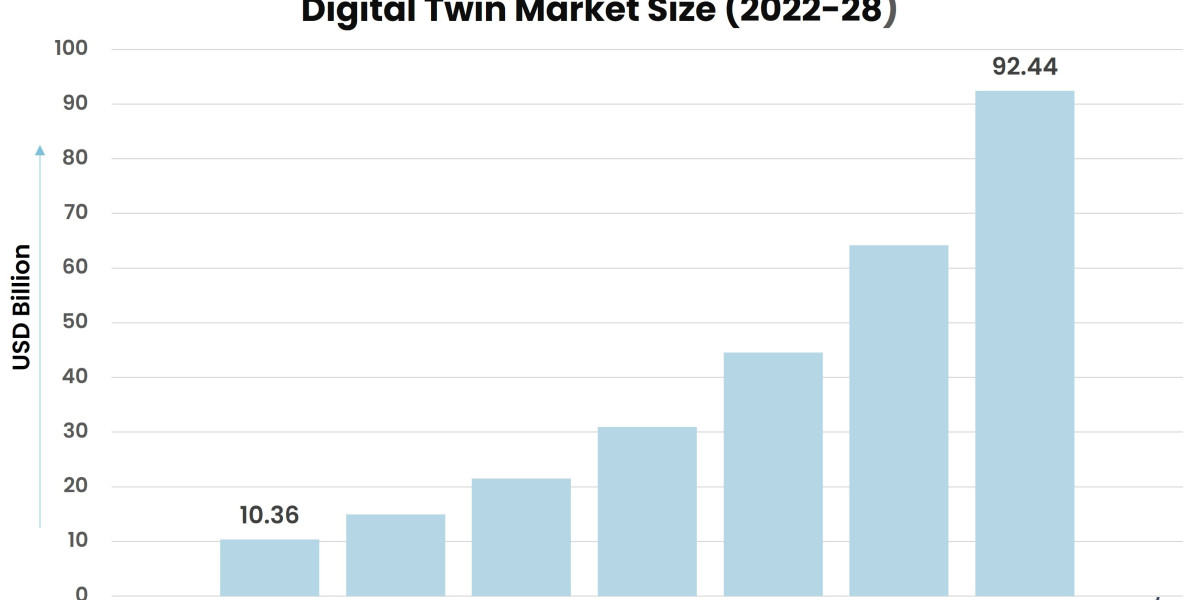The Digital Twin market is experiencing unprecedented growth, driven by advancements in technology, increasing demand for real-time data analytics, and the need for efficient asset management. As industries across the globe embrace digital transformation, the adoption of Digital Twin technology is becoming increasingly prevalent. This article explores the rapid growth of the Digital Twin market, highlighting the opportunities it presents and the challenges that need to be addressed to fully realize its potential.
According to Stratview Research, the digital twin market was estimated at USD 10.36 billion in 2022 and is likely to grow at a CAGR of 44.01% during 2023-2028 to reach USD 92.44 billion in 2028.
Understanding Digital Twins
A Digital Twin is a virtual replica of a physical asset, process, or system that allows for real-time monitoring, simulation, and analysis. By leveraging data from sensors and other sources, Digital Twins provide insights into the performance and condition of their physical counterparts, enabling predictive maintenance, optimization, and innovation.
Key Drivers of Market Growth
Several factors are contributing to the rapid growth of the Digital Twin market:
- Technological Advancements: The integration of Internet of Things (IoT), Artificial Intelligence (AI), and Big Data analytics is enhancing the capabilities of Digital Twins. These technologies enable the collection and analysis of vast amounts of data, providing deeper insights and more accurate simulations.
- Increasing Demand for Real-Time Data: In today’s fast-paced business environment, real-time data is crucial for making informed decisions. Digital Twins offer real-time monitoring and predictive analytics, allowing organizations to respond quickly to changing conditions and improve operational efficiency.
- Need for Efficient Asset Management: Digital Twins provide a comprehensive view of assets, helping organizations manage them more effectively. From predictive maintenance to performance optimization, Digital Twins enable proactive management, reducing downtime and operational costs.
- Digital Transformation Initiatives: Industries such as manufacturing, healthcare, energy, and transportation are undergoing digital transformation to enhance productivity and competitiveness. Digital Twins play a vital role in these initiatives by providing a digital representation of physical assets and processes, facilitating better planning and execution.
Opportunities in the Digital Twin Market
The growth of the Digital Twin market presents numerous opportunities for businesses and industries:
- Enhanced Product Development: Digital Twins allow for the virtual testing of products before they are physically manufactured. This accelerates the product development cycle, reduces costs, and improves the quality of the final product.
- Improved Operational Efficiency: By providing real-time insights and predictive analytics, Digital Twins help optimize operations. This leads to increased efficiency, reduced waste, and lower operational costs.
- Advanced Predictive Maintenance: Digital Twins enable predictive maintenance by analyzing data from sensors and predicting potential failures. This helps prevent unexpected breakdowns, extends the lifespan of assets, and reduces maintenance costs.
- Sustainable Practices: Digital Twins contribute to sustainability by optimizing resource usage and reducing waste. In industries such as energy and utilities, Digital Twins can help monitor and manage energy consumption, promoting greener practices.
- Enhanced Customer Experience: In sectors like healthcare, Digital Twins can create personalized treatment plans by simulating patient conditions and responses to treatments. This leads to better patient outcomes and improved customer satisfaction.
Challenges in Implementing Digital Twins
Despite the significant opportunities, the adoption of Digital Twin technology is not without challenges:
- Data Integration and Management: Implementing Digital Twins requires the integration of data from various sources, including IoT devices, sensors, and enterprise systems. Ensuring the accuracy, consistency, and security of this data is a major challenge.
- High Implementation Costs: The initial investment in Digital Twin technology can be substantial, encompassing costs related to hardware, software, and skilled personnel. Small and medium-sized enterprises (SMEs) may find it challenging to bear these costs.
- Technical Complexity: Developing and maintaining Digital Twins requires specialized knowledge and expertise. The complexity of integrating AI, IoT, and Big Data analytics can be a barrier for organizations lacking technical proficiency.
- Cybersecurity Risks: As Digital Twins rely on real-time data from connected devices, they are vulnerable to cyber threats. Ensuring the security and privacy of data is crucial to prevent unauthorized access and data breaches.
- Scalability Issues: Scaling Digital Twin solutions across large enterprises or multiple locations can be challenging. Ensuring that the technology can handle increased data volume and complexity while maintaining performance is essential.
The Future of the Digital Twin Market
The Digital Twin market is poised for continued growth as technological advancements and digital transformation initiatives accelerate. To fully harness the potential of Digital Twins, organizations need to address the challenges and invest in the necessary infrastructure, expertise, and cybersecurity measures.
As the market evolves, we can expect to see further innovations in Digital Twin technology, making it more accessible and affordable for businesses of all sizes. The integration of Digital Twins with emerging technologies such as 5G, blockchain, and augmented reality (AR) will open new avenues for application and innovation.
In conclusion, the rapid growth of the Digital Twin market presents significant opportunities for enhancing efficiency, sustainability, and innovation across various industries. By addressing the challenges and leveraging the benefits of Digital Twin technology, organizations can stay competitive and thrive in the digital age.



